文章目录
- 一、环境部署
- 二、导入原图
- 2.1 使用vit_s14的模型
- 三、使用其他模型
- 3.1 使用vit_b14的模型
- 3.2 使用vit_l14的模型
- 3.3 使用vit_g14的模型
一、环境部署
!git clone https://ghproxy.com/https://github.com/facebookresearch/dinov2.git
输出为:
Cloning into 'dinov2'...
remote: Enumerating objects: 141, done.
remote: Counting objects: 100% (96/96), done.
remote: Compressing objects: 100% (74/74), done. 71% (53/74)
remote: Total 141 (delta 40), reused 31 (delta 22), pack-reused 45
Receiving objects: 100% (141/141), 101.01 KiB | 348.00 KiB/s, done.
Resolving deltas: 100% (42/42), done.
命令是一个Git命令,用于克隆(Clone)名为"dinov2"的存储库。它使用了一个名为"ghproxy.com"的代理,用于加速GitHub的克隆操作。
!pip install -r /kaggle/working/dinov2/requirements.txt


!pip install scikit-learn -i https://pypi.tuna.tsinghua.edu.cn/simple

二、导入原图
%matplotlib inline
import matplotlib.pyplot as plt
import matplotlib.image as mpimgimage = mpimg.imread('/kaggle/input/demo-image/1 (4).png')plt.imshow(image)
plt.axis('off')
plt.show()# 输出图像尺寸
print("图像尺寸:{} x {} x {}".format(image.shape[0], image.shape[1], image.shape[2]))

图像尺寸:1376 x 920 x 3
我们需要切换为output的路径:
import osinput_path = "/kaggle/working/dinov2"
os.chdir(input_path)
2.1 使用vit_s14的模型
import torch
import torchvision.transforms as T
import matplotlib.pyplot as plt
import numpy as np
import matplotlib.image as mpimg
from PIL import Image
from sklearn.decomposition import PCA
import matplotlibpatch_h = 75
patch_w = 50
feat_dim = 384transform = T.Compose([T.GaussianBlur(9, sigma=(0.1, 2.0)),T.Resize((patch_h * 14, patch_w * 14)),T.CenterCrop((patch_h * 14, patch_w * 14)),T.ToTensor(),T.Normalize(mean=(0.485, 0.456, 0.406), std=(0.229, 0.224, 0.225)),
])dinov2_vits14 = torch.hub.load('', 'dinov2_vits14',source='local').cuda()features = torch.zeros(4, patch_h * patch_w, feat_dim)
imgs_tensor = torch.zeros(4, 3, patch_h * 14, patch_w * 14).cuda()img_path = f'/kaggle/input/demo-image/1 (4).png'
img = Image.open(img_path).convert('RGB')
imgs_tensor[0] = transform(img)[:3]
with torch.no_grad():features_dict = dinov2_vits14.forward_features(imgs_tensor)features = features_dict['x_norm_patchtokens']features = features.reshape(4 * patch_h * patch_w, feat_dim).cpu()
pca = PCA(n_components=3)
pca.fit(features)
pca_features = pca.transform(features)
pca_features[:, 0] = (pca_features[:, 0] - pca_features[:, 0].min()) / (pca_features[:, 0].max() - pca_features[:, 0].min())pca_features_fg = pca_features[:, 0] > 0.3
pca_features_bg = ~pca_features_fgb = np.where(pca_features_bg)pca.fit(features[pca_features_fg])
pca_features_rem = pca.transform(features[pca_features_fg])
for i in range(3):pca_features_rem[:, i] = (pca_features_rem[:, i] - pca_features_rem[:, i].min()) / (pca_features_rem[:, i].max() - pca_features_rem[:, i].min())# transform using mean and std, I personally found this transformation gives a better visualization# pca_features_rem[:, i] = (pca_features_rem[:, i] - pca_features_rem[:, i].mean()) / (pca_features_rem[:, i].std() ** 2) + 0.5pca_features_rgb = pca_features.copy()
pca_features_rgb[pca_features_fg] = pca_features_rem
pca_features_rgb[b] = 0pca_features_rgb = pca_features_rgb.reshape(4, patch_h, patch_w, 3)
plt.imshow(pca_features_rgb[0][...,::-1])
plt.savefig('features.png')
plt.show()
plt.close()
以下是代码的逐行中文解读:
import torch
import torchvision.transforms as T
import matplotlib.pyplot as plt
import numpy as np
import matplotlib.image as mpimg
from PIL import Image
from sklearn.decomposition import PCA
import matplotlib# 设置补丁(patch)的高度和宽度
patch_h = 75
patch_w = 50
# 特征维度
feat_dim = 384# 定义图像转换操作
transform = T.Compose([T.GaussianBlur(9, sigma=(0.1, 2.0)), # 高斯模糊T.Resize((patch_h * 14, patch_w * 14)), # 调整图像大小T.CenterCrop((patch_h * 14, patch_w * 14)), # 中心裁剪T.ToTensor(), # 转换为张量T.Normalize(mean=(0.485, 0.456, 0.406), std=(0.229, 0.224, 0.225)), # 标准化
])# 使用torch.hub加载dinov2_vits14模型并移至CUDA设备
dinov2_vits14 = torch.hub.load('', 'dinov2_vits14', source='local').cuda()# 创建用于存储特征和图像张量的零张量
features = torch.zeros(4, patch_h * patch_w, feat_dim)
imgs_tensor = torch.zeros(4, 3, patch_h * 14, patch_w * 14).cuda()# 图像路径
img_path = f'/kaggle/input/demo-image/1 (4).png'
# 打开图像并转换为RGB模式
img = Image.open(img_path).convert('RGB')
# 对图像进行转换操作,并将其存储在imgs_tensor的第一个位置
imgs_tensor[0] = transform(img)[:3]# 禁用梯度计算
with torch.no_grad():# 将图像张量传递给dinov2_vits14模型获取特征features_dict = dinov2_vits14.forward_features(imgs_tensor)features = features_dict['x_norm_patchtokens']# 重塑特征形状为(4 * patch_h * patch_w, feat_dim)
features = features.reshape(4 * patch_h * patch_w, feat_dim).cpu()# 创建PCA对象并拟合特征
pca = PCA(n_components=3)
pca.fit(features)# 对PCA转换后的特征进行归一化处理
pca_features = pca.transform(features)
pca_features[:, 0] = (pca_features[:, 0] - pca_features[:, 0].min()) / (pca_features[:, 0].max() - pca_features[:, 0].min())# 根据阈值进行前景和背景的区分
pca_features_fg = pca_features[:, 0] > 0.3
pca_features_bg = ~pca_features_fg# 查找背景特征的索引
b = np.where(pca_features_bg)# 对前景特征再次进行PCA转换
pca.fit(features[pca_features_fg])
pca_features_rem = pca.transform(features[pca_features_fg])# 对前景特征进行归一化处理
for i in range(3):pca_features_rem[:, i] = (pca_features_rem[:, i] - pca_features_rem[:, i].min()) / (pca_features_rem[:, i].max() - pca_features_rem[:, i].min())# 使用均值和标准差进行转换,个人发现这种转换方式可以得到更好的可视化效果# pca_features_rem[:, i] = (pca_features_rem[:, i] - pca_features_rem[:, i].mean()) / (pca_features_rem[:, i].std() ** 2) + 0.5# 创建RGB特征数组
pca_features_rgb = pca_features.copy()# 替换前景特征为转换后的特征
pca_features_rgb[pca_features_fg] = pca_features_rem# 将背景特征设置为0
pca_features_rgb[b] = 0# 重塑特征形状为(4, patch_h, patch_w, 3)
pca_features_rgb = pca_features_rgb.reshape(4, patch_h, patch_w, 3)# 显示第一个图像的RGB特征
plt.imshow(pca_features_rgb[0][...,::-1])
plt.savefig('features.png')
plt.show()
plt.close()
这段代码的功能是对给定的图像进行一系列处理和特征提取,并使用PCA对特征进行降维。然后,根据特定阈值对前景和背景进行区分,最后将特征可视化为RGB图像。请注意,其中的具体数值和路径可能需要根据您的实际数据和环境进行调整。
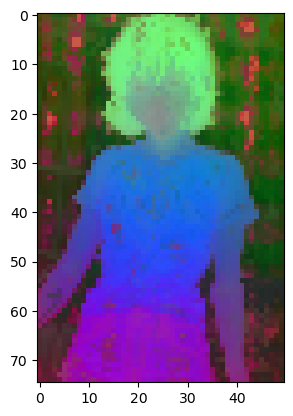
print(features)
print(features.shape)
我们的输出结果为:
tensor([[-1.3500, -4.8793, -1.4393, ..., 2.3347, 1.6834, -2.9632],[-0.4650, -6.4163, -1.5503, ..., 2.2055, 2.5527, -3.2553],[-0.6371, -6.2615, -0.7516, ..., 3.1827, 2.3861, -2.6838],...,[ 1.9385, 0.0726, -0.5395, ..., 0.3876, -1.4914, -4.5422],[ 1.6399, -0.0860, 0.4701, ..., 1.0180, -0.8897, -5.2614],[ 1.6084, -0.0669, 0.7341, ..., 1.0633, -0.9713, -5.3548]])
torch.Size([15000, 384])
降维后的特征为:
print(pca_features)
print(pca_features.shape)
输出的结果为:
[[ 0.81004055 2.458559 12.11051576][ 0.79562888 5.65071716 10.84007045][ 0.82050109 5.55007889 9.05274001]...[ 0.27618588 -18.96898667 19.48198916][ 0.31861323 -12.21414371 14.19802898][ 0.34356016 -10.82144825 13.74648131]]
(15000, 3)
features_dict
我们看一下字典的构成:
{'x_norm_clstoken': tensor([[ 2.2549, -1.5661, 4.4978, ..., 1.4984, -5.8642, -0.8560],[ 1.8816, 2.4343, 1.4931, ..., -1.3401, -2.5460, 1.3967],[ 1.8816, 2.4343, 1.4931, ..., -1.3401, -2.5460, 1.3967],[ 1.8816, 2.4343, 1.4931, ..., -1.3401, -2.5460, 1.3967]],device='cuda:0'),'x_norm_patchtokens': tensor([[[-1.3500, -4.8793, -1.4393, ..., 2.3347, 1.6834, -2.9632],[-0.4650, -6.4163, -1.5503, ..., 2.2055, 2.5527, -3.2553],[-0.6371, -6.2615, -0.7516, ..., 3.1827, 2.3861, -2.6838],...,[-0.8778, -0.0251, -0.2867, ..., 4.7801, -2.0887, -4.5910],[-1.2309, 0.2852, 0.7693, ..., 5.0635, -1.1529, -6.0175],[-1.7551, 1.1333, -0.0898, ..., 4.1885, -3.3197, -5.7227]],[[ 0.9131, -4.9736, -0.6238, ..., 0.2835, -0.3494, -0.4916],[ 1.0967, -6.0392, -0.7900, ..., 0.2323, 0.0510, 0.0176],[ 1.3852, -5.8056, -1.2573, ..., 0.0549, -0.3270, -0.4510],...,[ 1.9385, 0.0726, -0.5395, ..., 0.3877, -1.4914, -4.5422],[ 1.6399, -0.0860, 0.4701, ..., 1.0180, -0.8897, -5.2614],[ 1.6084, -0.0669, 0.7341, ..., 1.0633, -0.9713, -5.3548]],[[ 0.9131, -4.9736, -0.6238, ..., 0.2835, -0.3494, -0.4916],[ 1.0967, -6.0392, -0.7900, ..., 0.2323, 0.0510, 0.0176],[ 1.3852, -5.8056, -1.2573, ..., 0.0549, -0.3270, -0.4510],...,[ 1.9385, 0.0726, -0.5395, ..., 0.3877, -1.4914, -4.5422],[ 1.6399, -0.0860, 0.4701, ..., 1.0180, -0.8897, -5.2614],[ 1.6085, -0.0669, 0.7341, ..., 1.0633, -0.9713, -5.3548]],[[ 0.9131, -4.9736, -0.6238, ..., 0.2835, -0.3494, -0.4916],[ 1.0967, -6.0392, -0.7900, ..., 0.2323, 0.0510, 0.0176],[ 1.3852, -5.8056, -1.2573, ..., 0.0549, -0.3270, -0.4511],...,[ 1.9385, 0.0726, -0.5395, ..., 0.3876, -1.4914, -4.5422],[ 1.6399, -0.0860, 0.4701, ..., 1.0180, -0.8897, -5.2614],[ 1.6084, -0.0669, 0.7341, ..., 1.0633, -0.9713, -5.3548]]],device='cuda:0'),'x_prenorm': tensor([[[ 4.7546e-01, -3.4794e-02, 1.1905e+00, ..., 3.3896e-01,-1.2591e+00, -8.1724e-03],[-5.2994e-01, -3.0311e-01, -2.0162e-01, ..., 9.4372e-01,8.7399e-01, -3.2527e-01],[-1.5728e-01, -3.9359e-01, -2.1482e-01, ..., 9.0485e-01,1.2325e+00, -3.3923e-01],...,[-4.9091e-01, 1.1081e-02, 1.9814e-01, ..., 2.0630e+00,-8.5562e-01, -7.6588e-01],[-6.0861e-01, 5.2204e-02, 6.6299e-01, ..., 2.1127e+00,-3.8590e-01, -9.7335e-01],[-9.3785e-01, 1.2485e-01, 3.0359e-01, ..., 1.9137e+00,-1.5223e+00, -1.0352e+00]],[[ 4.4059e-01, 1.4807e-01, 5.9425e-01, ..., -3.4851e-01,-6.1687e-01, 2.0463e-01],[ 3.1511e-01, -3.3073e-01, 9.0955e-02, ..., 1.3627e-01,1.8562e-02, 4.2850e-02],[ 3.8695e-01, -4.1345e-01, 2.8734e-02, ..., 1.1916e-01,1.8061e-01, 1.2469e-01],...,[ 6.3855e-01, 1.9967e-03, 5.6187e-02, ..., 1.0780e-01,-5.0606e-01, -6.6095e-01],[ 5.6617e-01, 4.9071e-03, 4.8375e-01, ..., 3.7527e-01,-2.6194e-01, -7.9524e-01],[ 5.6790e-01, 1.4408e-02, 6.0538e-01, ..., 4.0537e-01,-2.9182e-01, -8.1226e-01]],[[ 4.4059e-01, 1.4807e-01, 5.9424e-01, ..., -3.4851e-01,-6.1687e-01, 2.0463e-01],[ 3.1511e-01, -3.3073e-01, 9.0957e-02, ..., 1.3627e-01,1.8564e-02, 4.2850e-02],[ 3.8695e-01, -4.1345e-01, 2.8733e-02, ..., 1.1916e-01,1.8061e-01, 1.2469e-01],...,[ 6.3855e-01, 1.9971e-03, 5.6186e-02, ..., 1.0780e-01,-5.0606e-01, -6.6095e-01],[ 5.6617e-01, 4.9067e-03, 4.8375e-01, ..., 3.7527e-01,-2.6194e-01, -7.9524e-01],[ 5.6790e-01, 1.4408e-02, 6.0538e-01, ..., 4.0536e-01,-2.9182e-01, -8.1226e-01]],[[ 4.4059e-01, 1.4807e-01, 5.9424e-01, ..., -3.4851e-01,-6.1687e-01, 2.0463e-01],[ 3.1511e-01, -3.3073e-01, 9.0956e-02, ..., 1.3627e-01,1.8562e-02, 4.2849e-02],[ 3.8695e-01, -4.1344e-01, 2.8735e-02, ..., 1.1916e-01,1.8061e-01, 1.2469e-01],...,[ 6.3855e-01, 1.9964e-03, 5.6189e-02, ..., 1.0780e-01,-5.0607e-01, -6.6095e-01],[ 5.6617e-01, 4.9066e-03, 4.8375e-01, ..., 3.7527e-01,-2.6194e-01, -7.9524e-01],[ 5.6790e-01, 1.4408e-02, 6.0538e-01, ..., 4.0537e-01,-2.9182e-01, -8.1226e-01]]], device='cuda:0'),'masks': None}
我们换一种可视化的方法:
patch_h = 75
patch_w = 50
feat_dim = 384transform = T.Compose([T.GaussianBlur(9, sigma=(0.1, 2.0)),T.Resize((patch_h * 14, patch_w * 14)),T.CenterCrop((patch_h * 14, patch_w * 14)),T.ToTensor(),T.Normalize(mean=(0.485, 0.456, 0.406), std=(0.229, 0.224, 0.225)),
])dinov2_vits14 = torch.hub.load('', 'dinov2_vits14',source='local').cuda()features = torch.zeros(4, patch_h * patch_w, feat_dim)
imgs_tensor = torch.zeros(4, 3, patch_h * 14, patch_w * 14).cuda()img_path = f'/kaggle/input/demo-image/1 (4).png'
img = Image.open(img_path).convert('RGB')
imgs_tensor[0] = transform(img)[:3]
with torch.no_grad():features_dict = dinov2_vits14.forward_features(imgs_tensor)features = features_dict['x_norm_patchtokens']features = features.reshape(4 * patch_h * patch_w, feat_dim).cpu()
pca = PCA(n_components=3)
pca.fit(features)
pca_features = pca.transform(features)
pca_features[:, 0] = (pca_features[:, 0] - pca_features[:, 0].min()) / (pca_features[:, 0].max() - pca_features[:, 0].min())pca_features_fg = pca_features[:, 0] > 0.3
pca_features_bg = ~pca_features_fgb = np.where(pca_features_bg)pca.fit(features[pca_features_fg])
pca_features_rem = pca.transform(features[pca_features_fg])
for i in range(3):# transform using mean and std, I personally found this transformation gives a better visualizationpca_features_rem[:, i] = (pca_features_rem[:, i] - pca_features_rem[:, i].mean()) / (pca_features_rem[:, i].std() ** 2) + 0.5pca_features_rgb = pca_features.copy()
pca_features_rgb[pca_features_fg] = pca_features_rem
pca_features_rgb[b] = 0pca_features_rgb = pca_features_rgb.reshape(4, patch_h, patch_w, 3)
plt.imshow(pca_features_rgb[0][...,::-1])
plt.savefig('features.png')
plt.show()
plt.close()
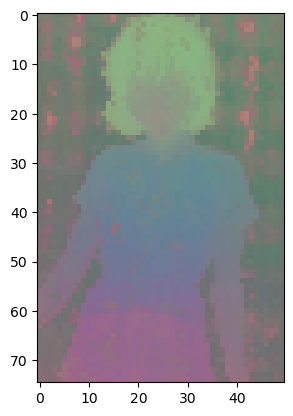
三、使用其他模型
3.1 使用vit_b14的模型
patch_h = 75
patch_w = 50
feat_dim = 768transform = T.Compose([T.GaussianBlur(9, sigma=(0.1, 2.0)),T.Resize((patch_h * 14, patch_w * 14)),T.CenterCrop((patch_h * 14, patch_w * 14)),T.ToTensor(),T.Normalize(mean=(0.485, 0.456, 0.406), std=(0.229, 0.224, 0.225)),
])dinov2_vitb14 = torch.hub.load('', 'dinov2_vitb14',source='local').cuda()features = torch.zeros(4, patch_h * patch_w, feat_dim)
imgs_tensor = torch.zeros(4, 3, patch_h * 14, patch_w * 14).cuda()img_path = f'/kaggle/input/demo-image/1 (4).png'
img = Image.open(img_path).convert('RGB')
imgs_tensor[0] = transform(img)[:3]
with torch.no_grad():features_dict = dinov2_vitb14.forward_features(imgs_tensor)features = features_dict['x_norm_patchtokens']features = features.reshape(4 * patch_h * patch_w, feat_dim).cpu()
pca = PCA(n_components=3)
pca.fit(features)
pca_features = pca.transform(features)
pca_features[:, 0] = (pca_features[:, 0] - pca_features[:, 0].min()) / (pca_features[:, 0].max() - pca_features[:, 0].min())pca_features_fg = pca_features[:, 0] > 0.3
pca_features_bg = ~pca_features_fgb = np.where(pca_features_bg)pca.fit(features[pca_features_fg])
pca_features_rem = pca.transform(features[pca_features_fg])
for i in range(3):# transform using mean and std, I personally found this transformation gives a better visualizationpca_features_rem[:, i] = (pca_features_rem[:, i] - pca_features_rem[:, i].mean()) / (pca_features_rem[:, i].std() ** 2) + 0.5pca_features_rgb = pca_features.copy()
pca_features_rgb[pca_features_fg] = pca_features_rem
pca_features_rgb[b] = 0pca_features_rgb = pca_features_rgb.reshape(4, patch_h, patch_w, 3)
plt.imshow(pca_features_rgb[0][...,::-1])
plt.savefig('features.png')
plt.show()
plt.close()
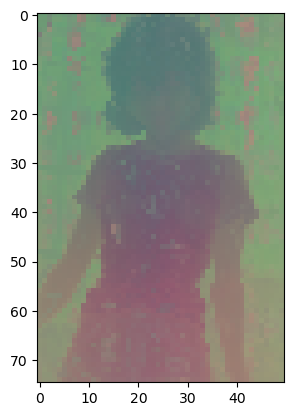
3.2 使用vit_l14的模型
patch_h = 75
patch_w = 50
feat_dim = 1024transform = T.Compose([T.GaussianBlur(9, sigma=(0.1, 2.0)),T.Resize((patch_h * 14, patch_w * 14)),T.CenterCrop((patch_h * 14, patch_w * 14)),T.ToTensor(),T.Normalize(mean=(0.485, 0.456, 0.406), std=(0.229, 0.224, 0.225)),
])dinov2_vitl14 = torch.hub.load('', 'dinov2_vitl14',source='local').cuda()features = torch.zeros(4, patch_h * patch_w, feat_dim)
imgs_tensor = torch.zeros(4, 3, patch_h * 14, patch_w * 14).cuda()img_path = f'/kaggle/input/demo-image/1 (4).png'
img = Image.open(img_path).convert('RGB')
imgs_tensor[0] = transform(img)[:3]
with torch.no_grad():features_dict = dinov2_vitl14.forward_features(imgs_tensor)features = features_dict['x_norm_patchtokens']features = features.reshape(4 * patch_h * patch_w, feat_dim).cpu()
pca = PCA(n_components=3)
pca.fit(features)
pca_features = pca.transform(features)
pca_features[:, 0] = (pca_features[:, 0] - pca_features[:, 0].min()) / (pca_features[:, 0].max() - pca_features[:, 0].min())pca_features_fg = pca_features[:, 0] > 0.3
pca_features_bg = ~pca_features_fgb = np.where(pca_features_bg)pca.fit(features[pca_features_fg])
pca_features_rem = pca.transform(features[pca_features_fg])
for i in range(3):# transform using mean and std, I personally found this transformation gives a better visualizationpca_features_rem[:, i] = (pca_features_rem[:, i] - pca_features_rem[:, i].mean()) / (pca_features_rem[:, i].std() ** 2) + 0.5pca_features_rgb = pca_features.copy()
pca_features_rgb[pca_features_fg] = pca_features_rem
pca_features_rgb[b] = 0pca_features_rgb = pca_features_rgb.reshape(4, patch_h, patch_w, 3)
plt.imshow(pca_features_rgb[0][...,::-1])
plt.savefig('features.png')
plt.show()
plt.close()
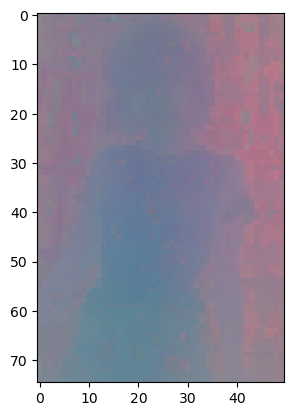
3.3 使用vit_g14的模型
patch_h = 75
patch_w = 50
feat_dim = 1536transform = T.Compose([T.GaussianBlur(9, sigma=(0.1, 2.0)),T.Resize((patch_h * 14, patch_w * 14)),T.CenterCrop((patch_h * 14, patch_w * 14)),T.ToTensor(),T.Normalize(mean=(0.485, 0.456, 0.406), std=(0.229, 0.224, 0.225)),
])dinov2_vitg14 = torch.hub.load('', 'dinov2_vitg14',source='local').cuda()features = torch.zeros(4, patch_h * patch_w, feat_dim)
imgs_tensor = torch.zeros(4, 3, patch_h * 14, patch_w * 14).cuda()img_path = f'/kaggle/input/demo-image/1 (4).png'
img = Image.open(img_path).convert('RGB')
imgs_tensor[0] = transform(img)[:3]
with torch.no_grad():features_dict = dinov2_vitg14.forward_features(imgs_tensor)features = features_dict['x_norm_patchtokens']features = features.reshape(4 * patch_h * patch_w, feat_dim).cpu()
pca = PCA(n_components=3)
pca.fit(features)
pca_features = pca.transform(features)
pca_features[:, 0] = (pca_features[:, 0] - pca_features[:, 0].min()) / (pca_features[:, 0].max() - pca_features[:, 0].min())pca_features_fg = pca_features[:, 0] > 0.3
pca_features_bg = ~pca_features_fgb = np.where(pca_features_bg)pca.fit(features[pca_features_fg])
pca_features_rem = pca.transform(features[pca_features_fg])
for i in range(3):# transform using mean and std, I personally found this transformation gives a better visualizationpca_features_rem[:, i] = (pca_features_rem[:, i] - pca_features_rem[:, i].mean()) / (pca_features_rem[:, i].std() ** 2) + 0.5pca_features_rgb = pca_features.copy()
pca_features_rgb[pca_features_fg] = pca_features_rem
pca_features_rgb[b] = 0pca_features_rgb = pca_features_rgb.reshape(4, patch_h, patch_w, 3)
plt.imshow(pca_features_rgb[0][...,::-1])
plt.savefig('features.png')
plt.show()
plt.close()
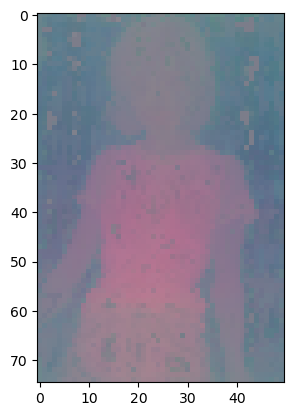
)
)





的实现)




)






